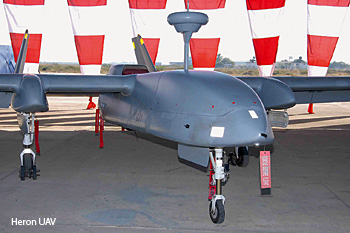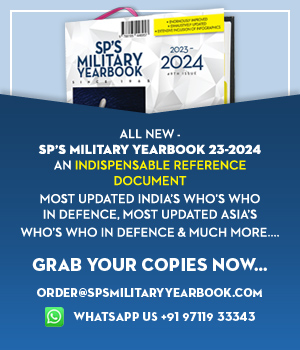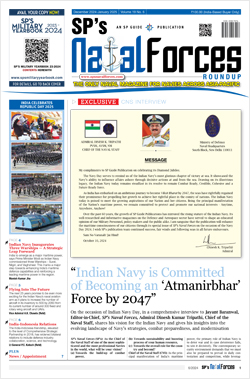INDIAN ARMED FORCES CHIEFS ON OUR RELENTLESS AND FOCUSED PUBLISHING EFFORTS

The insightful articles, inspiring narrations and analytical perspectives presented by the Editorial Team, establish an alluring connect with the reader. My compliments and best wishes to SP Guide Publications.

"Over the past 60 years, the growth of SP Guide Publications has mirrored the rising stature of Indian Navy. Its well-researched and informative magazines on Defence and Aerospace sector have served to shape an educated opinion of our military personnel, policy makers and the public alike. I wish SP's Publication team continued success, fair winds and following seas in all future endeavour!"

Since, its inception in 1964, SP Guide Publications has consistently demonstrated commitment to high-quality journalism in the aerospace and defence sectors, earning a well-deserved reputation as Asia's largest media house in this domain. I wish SP Guide Publications continued success in its pursuit of excellence.
- MoD initiates comprehensive review of Defence Acquisition Procedure 2020, pushes for defence reforms
- G7: The Swansong
- Kalinga Connect: South Asia to Polynesia
- Advanced MRSAM for India for a greater firepower
- Must Credit DRDO for Operation Sindoor, now what is next for defence R&D?
- Operation Sindoor | Day 2 DGMOs Briefing
- Operation Sindoor: Resolute yet Restrained
UAVs
For Maritime Surveillance
The Indian Navy has now decided to go for smaller unmanned aerial vehicles (UAVs) which can operate from ships. The Indian Navy and Indian Army have issued a request for proposal for 95 mini-UAVs. Companies which may be involved are Israel’s BlueBird Aero Systems, Innocon Limited and others.

buy albuterol sulfate inhaler online
buy ventolin puffer kristinasmith.us buy albuterol for nebulizer onlineMaritime domain domination is a very important aspect of naval operations. Maritime surveillance is a complex business as it involves subsurface, surface and air surveillance. Unmanned aerial vehicles (UAVs) have now assumed an important part for this role. Common applications of UAV platforms are for reconnaissance, surveillance, intelligence gathering and targeting. Some additional naval roles are:
- Search and rescue as amply proved during tsunami.
- It could carry a common data link and serve as a radio/data relay platform.
- Can enable a leap forward in payload sensor capability for naval surface fire.
- Provide real-time battle damage assessment.
- Operate as unmanned combat aerial vehicle.
The Indian Navy has also started inducting UAVs for maritime surveillance. So far they are using shore-based Israel Aerospace Industries (IAI) Heron medium-altitude long endurance (MALE) UAV and Searcher Mk II multi-mission tactical UAV. Heron is capable of MALE operations of up to 52 hours’ duration with a height ceiling of 35,000 feet. Searcher has an endurance of 20 hours, range of 300 km and height ceiling of 23,000 feet. It appears that the Indian Navy has now decided to go for smaller UAVs which can operate from ships. The Indian Navy and Indian Army have issued a request for proposal (RFP) for 95 mini-UAVs. Companies which may be involved are Israel’s BlueBird Aero Systems, Innocon and others. BlueBird Aero Systems makes UAV’s like MicroB for urban use, SkyliteB for tactical intelligence surveillance reconnaissance (ISR) for infantry tactical teams/special units, Boomrang for long-endurance missions and Blue Eye for civilian application. Piramal Enterprises, an Ajay Piramal Group company, has picked up some stake in BlueBird Aero Systems. Innocon has offered a newUAV called Spider. These type of UAVs will probably be used by the Navy for ship-based tactical role, complementing other shore-based UAVs; and state-of-the-art P-8I Neptune, long-range maritime patrol aircraft which is due for induction commencing early 2013 along with eight medium-range maritime reconnaissance aircraft which are also being planned for induction. It is also reported that IAI’s Malat Division, in cooperation with India, is developing a maritime naval rotary unmanned aerial vehicle (NRUAV), on a Chetak (Alouette III) platform which is widely used by the Indian Navy. It would have an endurance of six hours and radius of action would be 120 kilometres for providing early warning and detection of aircraft, cruise missiles, surface vessels and even subsurface activity. After being transformed into a pilotless all-weather platform, the helicopter will be equipped with multiple payloads for multimission performance, enabling aerial ship-borne resupply, maritime surveillance and other missions. The NRUAV features automatic take-off and landing from aviation capable ships and from unprepared landing sites. There is also a possibility of acquiring rotary-based systems like Northrop Grumman’s Fire Scout or a similar system in case there is a delay in the Chetak-based project.





